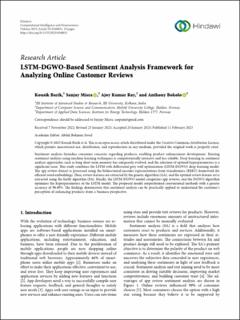| dc.contributor.author | Barik, Kousik | |
| dc.contributor.author | Misra, Sanjay | |
| dc.contributor.author | Ray, Ajoy Kumar | |
| dc.contributor.author | Bokolo, Anthony | |
| dc.date.accessioned | 2023-03-01T12:47:16Z | |
| dc.date.available | 2023-03-01T12:47:16Z | |
| dc.date.created | 2023-02-18T16:13:46Z | |
| dc.date.issued | 2023 | |
| dc.identifier.citation | Computational Intelligence and Neuroscience. 2023, 2023, Artikkel 6348831. | en_US |
| dc.identifier.issn | 1687-5265 | |
| dc.identifier.uri | https://hdl.handle.net/11250/3055002 | |
| dc.description.abstract | Sentiment analysis furnishes consumer concerns regarding products, enabling product enhancement development. Existing sentiment analysis using machine learning techniques is computationally intensive and less reliable. Deep learning in sentiment analysis approaches such as long short term memory has adequately evolved, and the selection of optimal hyperparameters is a significant issue. This study combines the LSTM with differential grey wolf optimization (LSTM-DGWO) deep learning model. The app review dataset is processed using the bidirectional encoder representations from transformers (BERT) framework for efficient word embeddings. Then, review features are extracted by the genetic algorithm (GA), and the optimal review feature set is extracted using the firefly algorithm (FA). Finally, the LSTM-DGWO model categorizes app reviews, and the DGWO algorithm optimizes the hyperparameters of the LSTM model. The proposed model outperformed conventional methods with a greater accuracy of 98.89%. The findings demonstrate that sentiment analysis can be practically applied to understand the customer’s perception of enhancing products from a business perspective. | en_US |
| dc.language.iso | eng | en_US |
| dc.publisher | Hindawi | en_US |
| dc.rights | Navngivelse 4.0 Internasjonal | * |
| dc.rights.uri | http://creativecommons.org/licenses/by/4.0/deed.no | * |
| dc.title | LSTM-DGWO-Based Sentiment Analysis Framework for Analyzing Online Customer Reviews | en_US |
| dc.type | Peer reviewed | en_US |
| dc.type | Journal article | en_US |
| dc.description.version | publishedVersion | en_US |
| dc.subject.nsi | VDP::Teknologi: 500 | en_US |
| dc.source.volume | 2023 | en_US |
| dc.source.journal | Computational Intelligence and Neuroscience | en_US |
| dc.identifier.doi | https://doi.org/10.1155/2023/6348831 | |
| dc.identifier.cristin | 2127208 | |
| dc.source.articlenumber | 6348831 | en_US |
| cristin.ispublished | true | |
| cristin.fulltext | original | |
| cristin.qualitycode | 1 | |

